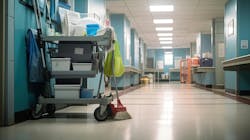It’s a given that schools and universities make it a priority to provide safe and healthful facilities for students and staff. The sudden spread of Covid-19 four years ago catapulted cleaning and maintenance to the top of the priority list. Cleaning and disinfecting desks, tables and other school surfaces, considered routine tasks before the pandemic, took on life-and-death urgency as custodians and maintenance staffs intensified their efforts to combat the disease and decrease the chances of catching it in school.
Some of the maintenance practices that schools emphasized at the outset of the Covid-19 pandemic were steps that should have been in place before the crisis prompted action. Recommendations from Centers for Disease Control and Prevention (CDC) for keeping school facilities clean and healthful were disseminated widely as the severity of the disease became evident. Now, with the pandemic in the rearview mirror, the urgency of those steps may have lessened, but their effectiveness in making facilities safer and more healthful for more common illnesses such as the flu remains.
Here is some of the CDC's guidance for slowing the spread of the flu:
- Know the difference between cleaning, disinfecting, and sanitizing.
Cleaning removes germs, dirt, and impurities from surfaces or objects. Cleaning works by using soap (or detergent) and water to physically remove germs from surfaces. This does not necessarily kill germs, but by removing them, it lowers their numbers and the risk of spreading infection. Disinfecting kills germs on surfaces or objects. It works by using chemicals to kill germs on surfaces or objects. This process does not necessarily clean dirty surfaces or remove germs, but by killing germs on a surface after cleaning, it can further lower the risk of spreading infection. Sanitizing lowers the number of germs on surfaces or objects to a safe level, as judged by public health standards or requirements. This process works by either cleaning or disinfecting surfaces or objects to lower the risk of spreading infection.
- Clean and disinfect surfaces and objects that are touched often
Schools should abide by their standard procedures for routine cleaning and disinfecting. Typically, this means daily sanitizing surfaces and objects that are touched often, such as desks, countertops, doorknobs, computer keyboards, hands-on learning items, faucet handles, phones, and toys. Standard procedures often call for disinfecting specific areas of the school, like bathrooms. clean Surfaces and objects that are visibly soiled should be cleaned immediately. If surfaces or objects are soiled with body fluids or blood, use gloves and other standard precautions to avoid coming into contact with the fluid.
- Simply do routine cleaning and disinfecting
Match cleaning and disinfecting to the types of germs you want to remove or kill. Flu viruses are relatively fragile, so standard cleaning and disinfecting practices are sufficient to remove or kill them. Special cleaning and disinfecting processes, including wiping down walls and ceilings, frequent use of room air deodorizers, and fumigating, are not necessary or recommended. These processes can irritate eyes, noses, throats, and skin; aggravate asthma; and cause other serious side effects.
- Clean and disinfect correctly
Follow label directions on cleaning products and disinfectants. Wash surfaces with a general household cleaner to remove germs. Rinse with water, and follow with an EPA-registered disinfectant to kill germs. If a surface is not visibly dirty, clean it with an EPA-registered product that both cleans (removes germs) and disinfects (kills germs) instead. Be sure to read the label directions carefully; there may be a separate procedure for using the product as a cleaner or as a disinfectant. Disinfection usually requires the product to remain on the surface for a certain period of time (e.g., letting it stand for 3 to 5 minutes).
Use disinfecting wipes on electronic items that are touched often, such as phones and computers. Make sure that the electronics can withstand the use of liquids for cleaning and disinfecting.
- Use products safely
Pay close attention to hazard warnings and directions on product labels. Cleaning products and disinfectants often call for the use of gloves or eye protection. For example, gloves should always be worn to protect the hands of people working with bleach solutions. Do not mix cleaners and disinfectants unless the labels indicate it is safe to do so.
- Handle waste properly
Workers should follow their school’s standard procedures for handling waste, which may include wearing gloves. Place no-touch waste baskets where they are easy to use. Throw disposable items used to clean surfaces and items in the trash immediately after use. Avoid touching used tissues and other waste when emptying waste baskets. Wash your hands with soap and water after emptying waste baskets and touching used tissues and similar waste.
About the Author
Mike Kennedy
Senior Editor
Mike Kennedy has been writing about education for American School & University since 1999. He also has reported on schools and other topics for The Chicago Tribune, The Kansas City Star, The Kansas City Times and City News Bureau of Chicago. He is a graduate of Michigan State University.
